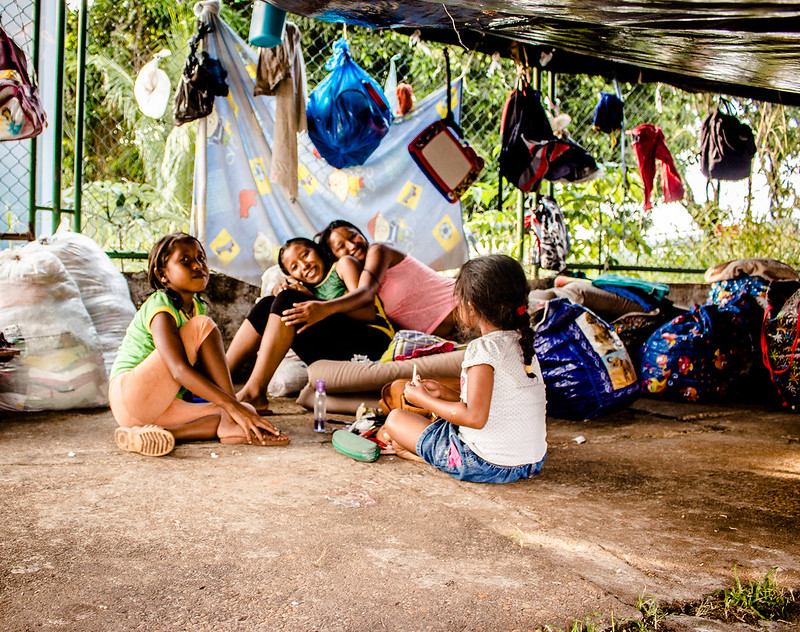Migration to Guyana
 Guyana has entered a pivotal economic development thanks to its emerging oil and gas sector, which increased its gross domestic product (GDP) by 32.2% in 2023 alone. This development has been attracting migrants from neighboring countries, mainly from Venezuela, where a political crisis has caused almost eight million Venezuelans to emigrate abroad. However, migrants in Guyana still face significant barriers to integrating into the workforce and broader society.
Guyana has entered a pivotal economic development thanks to its emerging oil and gas sector, which increased its gross domestic product (GDP) by 32.2% in 2023 alone. This development has been attracting migrants from neighboring countries, mainly from Venezuela, where a political crisis has caused almost eight million Venezuelans to emigrate abroad. However, migrants in Guyana still face significant barriers to integrating into the workforce and broader society.
An Overview
- Guyana discovered offshore oil reserves in 2015, with production starting in 2019. With a population of only 800,000 (about one-third of which live below the poverty line), one of the most impoverished countries in South America is now one of the fastest-growing economies in the world. This is making Guyana an attractive destination for economic migrants.
- Venezuelan political refugees make up the largest migrant group. Many have settled in Guyana’s rural areas, particularly the Indigenous Warao people.
- Although Guyana offers legal stay permits, health care and education regardless of a migrant’s status, the country is not a signatory of the United Nations’ (U.N.) 1951 Refugee Convention or the Complementary provisions of the International Labor Organization (ILO) Convention on Migrant Workers. This denies Venezuelans refugee status and exposes migrants in Guyana to a greater risk of exploitation and informal work.
- A Regional Migration Policy for Caribbean countries is set to launch in 2025 to address new migration trends.
Why Is Migration to Guyana Increasing?
The country’s growing oil and gas sector demands a larger workforce and both Guyanese and foreign nationals respond positively. In the year following the discovery of oil reserves, Guyana experienced more people entering than leaving the country. This trend is set to increase throughout the 2020s.
Furthermore, the ongoing humanitarian crisis in Venezuela has prompted an influx of forcibly displaced Venezuelans into neighboring Guyana. Venezuelans constitute about 3% of Guyana’s population. Many are fleeing the collapse of their country’s socioeconomic and political infrastructure, seeking relief from poverty and food insecurity.
What Is Life in Guyana Like for Migrants?
Migrants must first apply for a work permit through a work visa. The pre-arrival recruitment process for migrant workers in Guyana typically takes about 90 days. However, the process does not always conform to ethical standards, with some migrants reporting they had to pay to apply for a job.
Migrants can also request stay permits, subject to renewal every three months. However, these permits do not grant foreign nationals the right to work. The United Nations High Commissioner for Refugees (UNHCR) reports that 23,412 forcibly displaced Venezuelans have received stay permits since 2018. As this figure does not account for undocumented migrants, the number is likely much higher.
Due to these challenges, many migrants work in informal places and thus lack social protection. As the International Organization for Migration (IOM) noted, “The informal economy accounts for a significant amount of employment and livelihood, with official estimates ranging from 45% to 52% of total Guyanese economic activity.” This exposes migrants to labor exploitation and even human trafficking. Informality increases in rural areas where many Indigenous Venezuelans from the Warao community have settled.
Warao migrants account for 10% of Venezuelan nationals in Guyana. IOM reported in 2023 that 48% of Indigenous Venezuelans had no recognized status in Guyana. This makes them more vulnerable to exploitation in a context where Indigenous Guyanese already face disproportionately high poverty rates. The UNHCR and The New Humanitarian shared that the Warao community faces limited access to food, clean water, sanitation and education.
Language barriers compound these difficulties as Guyana is the only anglophone country in South America. Additionally, there are escalating tensions between the Guyanese and Venezuelan governments, with Venezuela claiming Guyana’s western Essequibo region. This dispute risks causing friction between Venezuelan migrants and Guyanese citizens.
How Are the Migration Issues in Guyana Being Addressed?
- A new Regional Migration Policy: The intergovernmental organization Caribbean Community (CARICOM), headquartered in Guyana, is developing a “people-centered” Regional Migration Policy. It aims to “streamline migration processes, enhance security, promote regional development” and improve protection for vulnerable migrant groups. CARICOM member states are set to review the policy in February 2025.
- Spanglish Bee: The UNHCR is playing an active role in improving migrant access to education. The annual “Spanglish Bee” competition is held in partnership with the Ministry of Education to improve refugee children’s English and Spanish skills.
- Supporting integration: Blossom Inc., a child-protection nonprofit in Guyana, has been collaborating with UNHCR to offer case management services to forcibly displaced children and their caregivers. These aim to develop migrants’ independence in Guyana, including providing information on accessing social services. These services supported 56 children and caregivers from July to September 2024.
Migration to Guyana has the potential to offer many domestic and regional benefits, including boosting the economy and providing refuge for Venezuelans escaping a humanitarian crisis. IOM reported that Guyana must welcome at least 100,000 people into its workforce to maximize its economic growth. Though it is uncertain how migration flows to Guyana will develop in the long term, organizations and world leaders are gradually seizing opportunities for improvement.
– Nesreen Yousfi
Nesreen is based in Watford, Hertfordshire, UK and focuses on Good News for The Borgen Project.
Photo: Flickr
